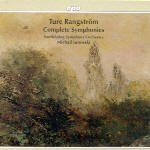Swedish composer Ture Rangström (1884–1947), a contemporary of Sibelius and Nielsen, was largely self-taught and defiantly independent in his approach to symphonic composition. Though well versed in counterpoint and sonata principles, Rangström largely rejected these techniques in favor of his own, which emphasized content over form, and drama over development. While there’s no doubting the dramatic and narrative power of the music, the lack of true counterpoint (his themes are not harmonically interrelated or contrasted, but rather blatantly juxtaposed) makes them ultimately unsatisfying as symphonies but perfectly suitable, as, for example, film scores, or as multi-movement symphonic poems (poets were his main inspiration). Viewed in that context they are highly effective. Those familiar with the music of Howard Hanson will have a good idea of the character of Rangström’s music, though his structures are looser and his orchestral style perhaps closer to fellow Swede Wilhelm Stenhammar. The far-flung, and super-heated Symphony No. 1 (a memorial to the poet August Strindberg) is aptly coupled to the symphonic poem Dithyramb (which is vaguely reminiscent of Strauss’s Don Juan) and the Spring Hymn. The similarly pot-boiling Symphony No.2 shares its disc with the surprisingly restrained Intermezzo dramatico, which is a pleasant sounding suite based on modal tunes. Symphony No. 3, Song under the Stars, is in one subdivided movement and is the most bombastic and least convincing of the four. The Invocatio symphony occupies a calmer, more meditative air than the other three, and features telling use of the organ. The Norrköping Symphony Orchestra plays as if they really believe in this music, as well they might under Michail Jurowski’s consistently inspired conducting. CPO captures these mostly massive scores, orchestrated for maximum visceral impact, in a large, well detailed acoustic.
































